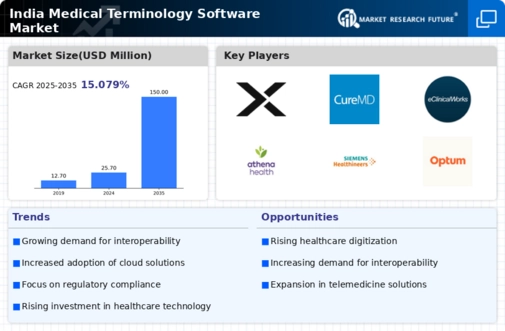Expansion of Telemedicine Services
The expansion of telemedicine services in India is significantly influencing the medical terminology-software market. With the increasing acceptance of remote consultations and digital health solutions, there is a growing need for software that can accurately capture and convey medical terminology in virtual settings. Telemedicine platforms require robust medical terminology software to ensure that healthcare providers can communicate effectively with patients and other professionals. This trend is likely to propel the market forward, as telemedicine is projected to account for approximately 30% of all healthcare consultations in India by 2026. Consequently, the demand for specialized software that supports telehealth initiatives is expected to rise, further bolstering the medical terminology-software market.
Rising Awareness of Health Data Security
The rising awareness of health data security is becoming a pivotal factor in the medical terminology-software market. As healthcare organizations in India increasingly prioritize patient privacy and data protection, there is a growing demand for software that incorporates robust security features. Compliance with data protection regulations, such as the Personal Data Protection Bill, is driving healthcare providers to seek medical terminology software that ensures secure handling of sensitive information. This heightened focus on data security is likely to influence purchasing decisions, with organizations favoring solutions that offer encryption and secure access controls. As a result, the medical terminology-software market may see a shift towards products that not only enhance operational efficiency but also prioritize data security.
Rising Demand for Healthcare Digitization
is seeing a notable surge due to As healthcare providers seek to enhance operational efficiency and patient care, the adoption of digital solutions is becoming imperative. According to recent data, the healthcare IT market in India is projected to grow at a CAGR of approximately 15% from 2023 to 2028. This trend indicates a robust shift towards electronic health records and medical terminology software, which facilitate better data management and communication among healthcare professionals. The push for digitization is further fueled by government initiatives aimed at improving healthcare infrastructure, thereby creating a conducive environment for the medical terminology-software market to thrive.
Increased Investment in Healthcare IT Infrastructure
Investment in healthcare IT infrastructure is a key driver for the medical terminology-software market in India. As healthcare facilities upgrade their technological capabilities, there is a corresponding need for sophisticated software solutions that can manage medical terminology efficiently. Government initiatives aimed at enhancing healthcare infrastructure, coupled with private sector investments, are likely to create a favorable environment for the growth of this market. Reports indicate that the Indian healthcare IT market is expected to reach a valuation of $10 billion by 2025, highlighting the potential for medical terminology software to play a crucial role in this transformation. The influx of capital into healthcare IT is anticipated to stimulate innovation and adoption of advanced software solutions.
Growing Emphasis on Data Accuracy and Standardization
In the medical terminology-software market, the emphasis on data accuracy and standardization is becoming increasingly critical. Healthcare organizations in India are recognizing the importance of precise medical coding and terminology to ensure effective communication and reduce errors in patient care. The Indian healthcare sector has seen a rise in the implementation of standardized coding systems, such as ICD-10, which enhances the interoperability of health information systems. This focus on accuracy is likely to drive the demand for advanced medical terminology software that can support these standards. As a result, the market is expected to witness a growth trajectory, with an estimated increase in software adoption rates by around 20% over the next few years.




















Leave a Comment